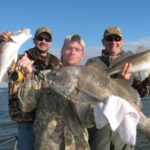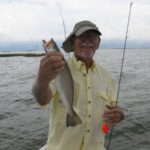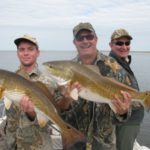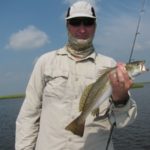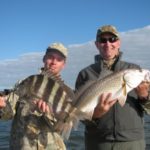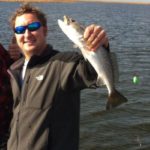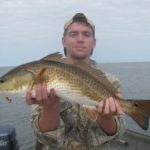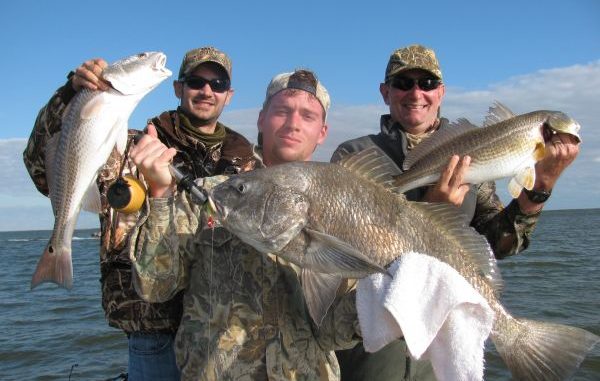
April is one of those transition months that can be tough to fish — so you have to have plenty of options. Here’s how to score in Port Sulphur and Empire.
“Redfish in April?” Artie laughed as Doc mentioned our forthcoming fishing trip. “Man, redfish ain’t ‘runnin now! Dey run in da fall! You guys gotta be outcha mind!
“Don’t waste your time. Fall’s for reds in da marsh — and bull croakers in da lake! Spring’s for specks!”
Nobody ever accused Artie of being on the cutting edge of fashion, be it sports, fishing or actual clothes. His Saint’s shirt, for instance, shows Danny Abramowicz. To show it off he’ll often swing open the jacket of his polyester leisure suit, in lime green, of course.
And for comfort and style?
“Ya ain’t gonna beat a pair of Tom McCann Hush Puppies — though I got ’em a little cheaper at Shoe Town,” he winks.
Pelayo insists that when Brandon Tartikoff came up with the New Orleans-based game show “N.O. It Alls” back in the ’90s about loud-mouthed, know-it-all Yats, Artie just had to be the inspiration.
But Artie insists his one “conversation” with Tartikoff at the Endymion Ball was rather brief. He actually spent most of the time hobnobbing with Al Scramuzza, his idol.
Often you hear a certain accent and wonder why the radio in the next room is playing Benny Grunch and the Bunch’s “12 Yats of Christmas” in mid-summer? Then you walk in and see it’s actually Artie mouthing off his famous expertise on something or other.
“A-six-pack-a-Dixie” never sounded as Benny Grunch-like as when Artie rasps it in normal conversation, not that Artie actually converses. That manner of human interchange requires allowing the other party a word in edgewise. When “conversing” with Artie — good luck with dat! — as Spencer should have well known by now.
But Spence insisted on trying to explain to Artie:
• that, in fact, for the past two weekends we’d been mopping up on shallow-water reds, along with school specks and a few sheepshead in the upper marshes of the Port-Sulphur/Empire area — really the only marsh worthy of the name remaining in that area.
• that, in fact, this type of fishing had itself become a tradition of sorts for us over the past few years.
• that this time of year, water in the area — unlike that closer to the river-roiled Gulf — gets super clear and choked with black algae in portions. This algae serves as a haven and food source for the shrimp, minnows, finger mullet and juvenile blue crabs. So naturally the creatures (specks, reds, sheepshead, puppy drum, flounder) that eat the algae-eaters also swarm into the area.
Oddly, sheepshead are immensely fond of the algae itself. Jerald Horst’s Angler’s Guide to Fishes of the Gulf of Mexico points to studies showing that sheepshead are pretty much omnivorous; like wild swine, they’ll eat both plant and animal matter — algae and sea grasses along with crabs, clams, barnacles and assorted mollusks and crustaceans. One old study showed that the diet for sheepshead in Lake Pontchartrain was about half sea grasses. Obviously “Da Lake” had many more eel grass beds at the time, but still.
Pelayo chimed in to explain the rationale for fishing this area.
“Look Artie,” he started as the crowd gathered, “most of us have one, maybe two days a week, to fish — ya unnerstan’? So we like to have — not only a Plan B — but also a Plan C — ya unnerstan’ what I’m saying?
“Weather can get kinda crazy in early April. A cold front could still barrel through and blow out all the waaaw-daw in the marsh — ya follow me? We ain’t gonna be catching grassy shoreline reds with that scenario. So maybe we’ll try for the school specks in the open bays.
“But the wind could shift to the southeast, start howling and muddy up the open bays. We ain’t gonna be catching too many specks under the birds under that scenario — ya unnerstan’ what I’m saying?
“Good thing about this area this time of year is the sheepshead that gang up in the deeper cuts and bayous. We can always fall back on the sheepshead to pretty up da box a little. They always come through for us, if the specks and reds cancel on us for some reason — ya follow me?”
Artie, smirking smart-alecky and looking around for applause as usual, wasn’t listening to Spencer or Pelayo.
But a few of the other guests at Doc’s Crawfish boil, including Doc’s brother-in-law Chuck from Memphis, were absolutely rapt — but not with Artie. Instead they crowded around Pelayo, heard him out, then smilingly asked him questions that were — get this — not rhetorical!
Then they nodded and smiled politely while they attentively — get this — listened to the answers! Then they followed up with other questions that were — get this — not sarcastic or cynical! None of the questions — get this — were sly put-downs meant to showcase the questioners’ superior knowledge on the matter!
Needless to say, these folks were all from out of state. So let’s forgive them.
Two mornings later we found ourselves motoring westward across Adams Bay.
“Check ’em out!” Pelayo said, pointing as we neared the northwest corner of the bay.
Ah yes, black-headed gulls hovering and dipping (not terns diving and smacking the water, which aren’t as reliable a signal of specks) around the oyster poles. More gulls (not terns) rested in the water in little bunches.
“Know what DAT means!” Pelayo whooped, as he cut the motor and we started drifting toward the action. “They’re HERE!”
Doc was first to cast and hook up. His rod was high overhead as the school speck hit the surface, rattling its mouth and frothing the water — and getting the rest of us seriously PUMPED! — as we frantically jerked out the rods and put on corks. The various plastic jigs and shad-rigs were already on the poles.
And, as we know by now, when you’re woykin da birds, the subtleties of jig color and design don’t seem to be a paramount concern of the.
“Got one here!” Pelayo yelled from the bow, as his ultra-light reel starting to sing.
“Another here!” yelled Chuck from beside him.
Pelayo had cast green beetles in tandem under his popping cork. Blake had purple ones with green tails under his cork.
“YEP — we’re on ’em!” I finally joined the chorus, 30 seconds after casting with shad rigs under my cork.
As I was saying before I was so rudely interrupted: The subtleties of the jig design and color don’t seem like a paramount concern of spring specks in a feeding frenzy under birds, especially in the Bastian/Bay Adams area.
One of my shad rigs was white the other yellow. The yellow one (on top) had a 13 ½-inch speck. The white one (on bottom) had an 11-inch white trout. Both went promptly and proudly into da box.
After 12 more trout (seven specks, five whites) the gafftops showed up. So we cranked up and roared off toward Grand Bayou.
Then we turned into the “7-Foot Canal,” as locals call it, and finally entered another open area of eroded marsh that basically makes up what used to be the marsh between Lake Washington and Grand Bayou.
Sadly, it’s disappearing fast around here, too, but there’s still enough marsh to fish. And the sad — or bittersweet — part is that an eroding marsh is actually good for fishing, especially for reds, whose top food item are crabs, especially the smaller ones that hide out in the grass and crevices of an eroding marsh. A high tide lets the reds enter these areas, where they can root around, snatching up the little morsels along with the cocahoes that also hang around in this grassy stuff.
“They call this no-man’s land, Chuck,” Pelayo said as he pulled back on the throttle. “Pretty shallow, usually. This area was once marsh, too. But we’re OK today. High tide.”
“High and falling,” I added. “Perfect for reds.”
Pelayo rumbled toward a grassy shoreline a couple hundred yards off. I looked down and saw that the water was ideal for reds — it was murky.
I’d been a little worried on the way over; the water looked super clear, as often happens in the more sheltered waters.
But for whatever reason, for the type of fishing we do (shrimp-tipped jigs under corks cast toward grassy shorelines), clear water skunks us. Maybe the reds see us better that way?
Whatever. We always do better on high tides and murky to filthy water for reds.
We find market shrimp indispensable for this type of fishing, too.
We zeroed in, as always, on the windward side of the bay. As we approached, I saw the murky waves lapping over the grass on this eroded shoreline, and could make out what looked like a current line.
Just as importantly, the depth finder showed 2 feet.
The place had rat red, puppy drum and sheepshead written all over it!
My cork hit the water first. My shad-rigs were sweetened with half a shrimp each.
The cork hit about 2 feet from the grass, and immediately a slight current started pushing it along.
Another favorable sign.
Grassy, wave-lapped shoreline in 2-foot depths: You couldn’t order a better situation, I was thinking to myself when — “WHOA!” — my cork plunged, even before my first pop.
I reared back, and it was off to the races.
“WOW!” was all Chuck could manage while watching my spool empty and the wake barreling across the shallows.
“He’s turning!” I roared. “He’s turning toward the open waaaw-daw! He’s gotta be a monster!”
“Monster hardheads and sailcats do that, too,” Pelayo smirked.
“This ain’t no hardhead, podnuh! Look at that!” I waved my bowed rod in front of his face. “And listen to that!”
I put my spool inches from his ear.
“Alright, alright!” Pelayo yelled right before turning toward a whooping Doc.
“And this ain’t no hardhead either!” Doc whooped with his bent rod high overhead.
“What the …? Did he get off?”
Doc’s pole straightened and his line went slack as he cranked the reel.
“Heck no!” I yelled. “He’s swimming in on ya! He’s a monster red, too, heading for the open waaaw-daw like mine!”
Just as Pelayo reeled in the slack, his reel gave a mighty screech to prove my point, and the rod was almost jerked from his grasp.
“Oh YEAH!” he beamed while looking over. “Feels like a red alright!”
I was still savoring mine. His berserk run took him back and forth in front of the boat as I gained — then lost — line. I held my pole high overhead, and bellowed my joy to the heavens, just as the fish exploded in a froth of grey and copper.
“Eight-pounder for sure!” I raved, as it barreled off on another run and I felt the muscles in my forearms already bunching up from the strain of the battle (on top of the ones against a few huge gafftops earlier.)
“Forget it, Chuck!” I saw him reaching for the net. “Go get yourself one. They’re stacked up along that shoreline, podnuh. I can net mine myself.”
Chuck smiled, and his shrimp-tipped green beetle 2 feet under a cork was on its way shoreward posthaste. I was just dipping the net under mine when he erupted.
“Whoo! Yeah! Whoo! Yeah! Awesome!”
He had a crazy look on his face as a wake streaked across the shoreline and plunged into the flooded grass itself.
“Work him out, Blake!” Pelayo counseled. “Work him outta that grass so he won’t cut the line!”
So Chuck tightened his drag a bit.
“THERE!” He beamed. “Got him out!”
Now his fish streaked for the open water, too.
This spot yielded four reds, two drum and a flounder before petering out. That’s the thing with this type of fishing: You never really find massive schools in any one place. But you usually find enough fish and enough variety to make for an action-packed trip.
The next spot had a nice current, too — but a little too nice.
The cork barreled across the point too fast. We caught two 15 9/10-inch rat reds, and pulled up the anchor.
Next spot was another grassy point, with murky water, oyster bottom and wind-lapped shoreline. Doc cranked in a nice sheepshead on his first cast. Then a red. Then Pelayo caught another red.
Soon we were in Bayou Maringuion, where the water was amazingly clear, as befits this relatively sheltered marsh area.
“Watch this, Chuck.”
Pelayo was already baiting up a simple jighead (no rubber, just the head) with shrimp as I eased the boat against the shoreline where a pond emptied into the bayou.
Soon we had all cast out with similar, corkless rigs. In another month, this would be a simple invitation to load up on hardheads, but in early April the water is still cool enough to keep the hardheads at bay — most of them, that is.
In three minutes, I felt the tapping. I raised my rod tip a bit and felt pressure, another tap, so — WHAM! — I set the hook, and it was off to the races.
“RIGHT!” I howled as my rod bucked.
In short order, I hauled aboard a 3-pound sheepshead, a fish Chuck (an out-of-towner) had always appreciated.
In seconds, he was hauling one in himself with his face creased in a heavy grin.
Pelayo was next with another sheepshead.
All of our lines were bunched up with algae, which we peeled off after chunking the sheepshead in “Da Box.” But we weren’t complaining.
We ended the day with nine reds, four puppy drum, two flounder, 17 school specks, five white trout and a dozen sheepshead.
A miniscule fraction of four-man limits — but what a blast!
The action seemed non-stop. And the fish feast (variously fried, bronzed and grilled) at Docs the following week made many enthusiastic converts to our plan A-, B-, and C-type fishing.
But Artie, needless to add, wasn’t impressed.
“Y’all lucked out,” he snorted. “That’s all.”
